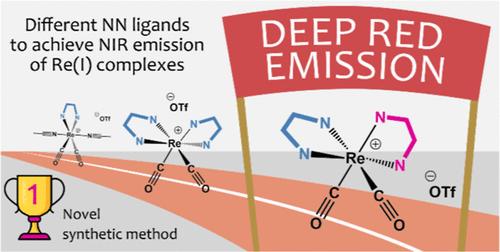变红:两种不同二亚胺配体的二羰基Re(I)配合物的合成及近红外发光。
IF 4.7
2区 化学
Q1 CHEMISTRY, INORGANIC & NUCLEAR
引用次数: 0
摘要
本文提出了一种以双乙腈铼(I)前体[Re(NN1)(CO)2(NCMe)2]OTf为原料,合成通式[Re(NN1)(NNi)(CO)2]OTf的Re(I)混合配体双二亚胺二羰基配合物(NN1 =新根碱)的高效合成方法。这种方法允许引入不同的二亚胺配体,其中包含融合的部分和吸电子官能团。所有的配合物在溶液和固体状态下都表现出深红色到近红外(NIR)的发射,达到845 nm。对所考虑的配合物的电子结构进行了TD-DFT计算,证实了发射激发态的3MLCT特征。本文章由计算机程序翻译,如有差异,请以英文原文为准。

Shift It to the Red: The Synthesis of Dicarbonyl Re(I) Complexes with Two Different Diimine Ligands and Near-Infrared Luminescence
In this contribution, we present an efficient synthetic method for obtaining Re(I) mixed-ligand bis-diimine dicarbonyl complexes of general formula [Re(NN1)(NNi)(CO)2]OTf (NN1 = neocuproine), starting from bis-acetonitrile rhenium(I) precursor [Re(NN1)(CO)2(NCMe)2]OTf. This method allows introduction of different diimine ligands, which contain fused moieties and electron-withdrawing functional groups. All complexes obtained demonstrate deep red to near-infrared (NIR) emission both in solution and in the solid state, achieving 845 nm. The 3MLCT character of the emissive excited state was confirmed by TD-DFT calculations of the electronic structures for the complexes considered.
求助全文
通过发布文献求助,成功后即可免费获取论文全文。
去求助
来源期刊

Inorganic Chemistry
化学-无机化学与核化学
CiteScore
7.60
自引率
13.00%
发文量
1960
审稿时长
1.9 months
期刊介绍:
Inorganic Chemistry publishes fundamental studies in all phases of inorganic chemistry. Coverage includes experimental and theoretical reports on quantitative studies of structure and thermodynamics, kinetics, mechanisms of inorganic reactions, bioinorganic chemistry, and relevant aspects of organometallic chemistry, solid-state phenomena, and chemical bonding theory. Emphasis is placed on the synthesis, structure, thermodynamics, reactivity, spectroscopy, and bonding properties of significant new and known compounds.
 求助内容:
求助内容: 应助结果提醒方式:
应助结果提醒方式:


